+Search query
-Structure paper
| Title | Structural insights into the high-affinity IgE receptor FcεRI complex. |
|---|---|
| Journal, issue, pages | Nature, Vol. 633, Issue 8031, Page 952-959, Year 2024 |
| Publish date | Aug 21, 2024 |
 Authors Authors | Meijie Deng / Shuo Du / Handi Hou / Junyu Xiao /  |
| PubMed Abstract | Immunoglobulin E (IgE) plays a pivotal role in allergic responses. The high-affinity IgE receptor, FcεRI, found on mast cells and basophils, is central to the effector functions of IgE. FcεRI is a ...Immunoglobulin E (IgE) plays a pivotal role in allergic responses. The high-affinity IgE receptor, FcεRI, found on mast cells and basophils, is central to the effector functions of IgE. FcεRI is a tetrameric complex, comprising FcεRIα, FcεRIβ and a homodimer of FcRγ (originally known as FcεRIγ), with FcεRIα recognizing the Fc region of IgE (Fcε) and FcεRIβ-FcRγ facilitating signal transduction. Additionally, FcRγ is a crucial component of other immunoglobulin receptors, including those for IgG (FcγRI and FcγRIIIA) and IgA (FcαRI). However, the molecular basis of FcεRI assembly and the structure of FcRγ have remained elusive. Here we elucidate the cryogenic electron microscopy structure of the Fcε-FcεRI complex. FcεRIα has an essential role in the receptor's assembly, interacting with FcεRIβ and both FcRγ subunits. FcεRIβ is structured as a compact four-helix bundle, similar to the B cell antigen CD20. The FcRγ dimer exhibits an asymmetric architecture, and coils with the transmembrane region of FcεRIα to form a three-helix bundle. A cholesterol-like molecule enhances the interaction between FcεRIβ and the FcεRIα-FcRγ complex. Our mutagenesis analyses further indicate similarities between the interaction of FcRγ with FcεRIα and FcγRIIIA, but differences in that with FcαRI. These findings deepen our understanding of the signalling mechanisms of FcεRI and offer insights into the functionality of other immune receptors dependent on FcRγ. |
 External links External links |  Nature / Nature /  PubMed:39169187 PubMed:39169187 |
| Methods | EM (single particle) |
| Resolution | 2.89 - 3.58 Å |
| Structure data | EMDB-39029, PDB-8y81: EMDB-39032, PDB-8y84: EMDB-39033, PDB-8z0t: EMDB-60089, PDB-8zgs: EMDB-60090, PDB-8zgt: |
| Chemicals |  ChemComp-NAG:  ChemComp-Y01: |
| Source |
|
 Keywords Keywords | IMMUNE SYSTEM / complex / antibody / ANTIBDOY / ANTIMICROBIAL PROTEIN / MEMBRANE PROTEIN |
 Movie
Movie Controller
Controller Structure viewers
Structure viewers About Yorodumi Papers
About Yorodumi Papers




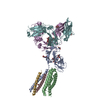

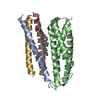

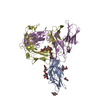

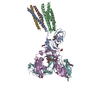

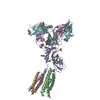

 homo sapiens (human)
homo sapiens (human)